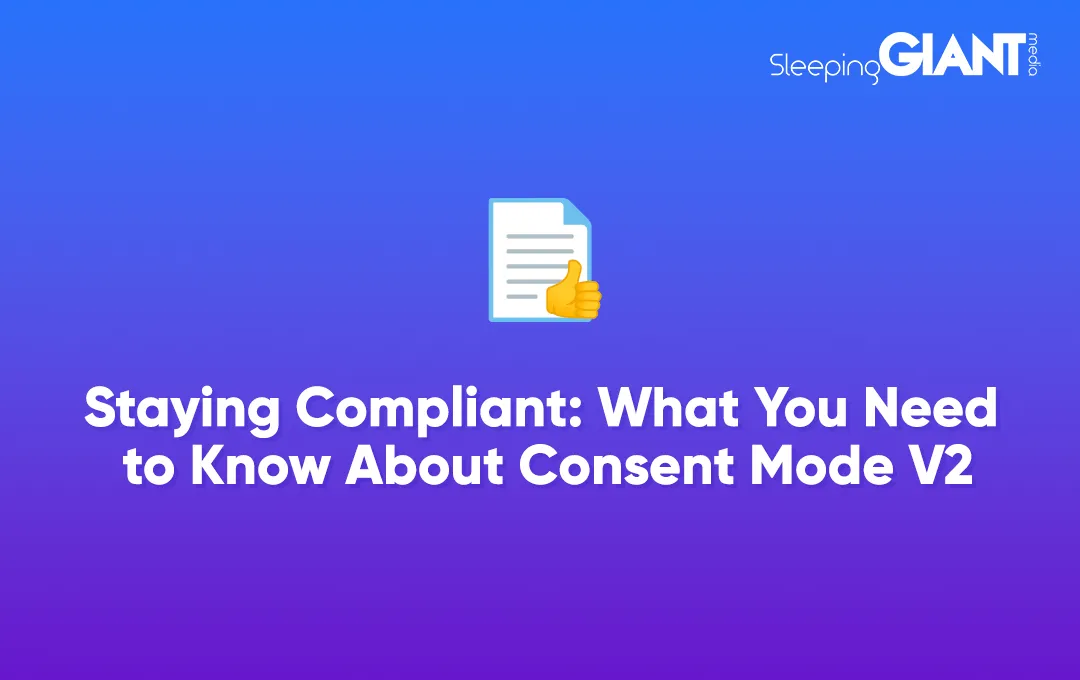
Staying Compliant: What You Need to Know About Consent Mode v2
We know Google likes to keep us on our toes and the beginning of 2024 is no different. Whilst the last half of 2023 saw multiple core algorithm updates, Google’s focus has, at least for now, turned to privacy and data protection. Businesses and marketers first challenge to tackle is the introduction of consent mode v2.
With the deadline to implement the new version fast approaching, we are on hand to make sure you know what consent mode v2 is and what you need to do to ensure you stay compliant.
Read on to find out all you need to know.
What is consent mode?
If you’re new to consent mode and you’re not sure what it is or means, Google defines consent mode as letting you communicate your users’ cookie or app identifier consent status to Google. This may sound daunting, but essentially, it’s allowing users to communicate their consent choices on your website or app, adapt Google tag behaviour and enable Google to model for gaps in conversions. You can then use platforms such as Google Analytics to track activity and performance.
If a user rejects consent, this information will be sent to Google and their activity won’t be tracked, ensuring user privacy.
The key theme is Google. If your business uses Google services, this update affects you.
You may be wondering how this is all managed. Well, if you have a Consent Management Platform in place, you can use the system in conjunction with consent mode to ensure you’re obtaining the legal consents required, for example through a cookie banner. You can also use custom implementation to obtain user consent.
Ultimately, this feature is designed to maintain standards in relation to user safety and privacy which is why it’s important. However, there is a key update to be aware about when it comes to consent mode. You may have noticed the title of our piece mentioning v2 (yes, there was a v1), so make sure you keep reading to find out the recent change and how to implement the new consent mode.
Why is consent mode important?
Consent mode is important because of user consent. If you’re based in the EU or the UK, then you’ll know that GDPR (General Data Protection Regulation) controls how personal information is used and stored by organisations and businesses.
71% of people say that they trust brands that are open and honest about the way that their data is being used. It’s expected from users that their data is handled carefully, and it’s also a right that needs to be upheld.
How does consent impact business?
Unfortunately, consent can have an impact on data. Allowing people to opt out of cookies — and needing to block cookies and tags from firing from time to time will have an impact on the data.
However, consent mode aims to try and limit the amount of data loss. When a user consents, the tracking would work as it normally would, whether through GA4 or Google Ads tags. If a user rejects, businesses would need to stop cookies from being dropped by certain tags.
For those users that did convert, that data would go into conversion modelling to be reported at the end. You’ve got your data collection, your observed data, and your modelled data — and this is consent mode helping by adding to that model data. That data feeds into your measurement, your attribution, and importantly, if you’re doing anything like Google Ads, it would then go into any smart bidding.
Any smart bidding that you have in place, you want to give Google as much data as possible for it to make the best decisions it possibly can. Consent mode allows more of that data to go into modelling, which should give greater outcomes in terms of revenue or conversions.

How does consent mode v2 differ from v1?
Consent mode v1 was largely focused on ensuring cookies were not dropped for users on sites and looking to minimise measurement loss, enabling modelling where a user opted out, while v2 is much more focused on compliance to consent for users receiving personalised ads.
The key difference to be aware of is that the implementation of consent mode v2 is mandatory for all businesses that use Google services.
Yes, you heard us correctly.
Whilst v1 of consent mode was optional for businesses to implement, meaning if you wanted to have a cookie banner on your website you could but you didn’t have to, all businesses now need to ensure they have consent options for users visiting their website or app if they want to use remarketing and personalisation features.
The changes to your website need to be implemented by the end of March, but ideally the sooner the better.
How will Google enforce consent mode?
Google hasn’t indicated at this time how it intends to enforce consent mode. This will likely come slightly later in the year, but it is still very important to have it in place now.
What are the risks of not implementing consent mode v2?
Simply put, Google advertisers that don’t have consent mode v2 in place by the end of March 2024 will have their audiences and enhanced conversions affected. This means that any Google platforms that you use to track performance, i.e. Google Analytics, won’t have the full picture of your website or app activity and your reporting data won’t be accurate.
Therefore, it can’t be stressed enough how important it is to enable consent mode v2 on your website. Not only from a data protection and user safety point of view, but from a business and performance perspective too.
How to implement consent mode v2?
Luckily, for businesses that already have a Consent Management Platform (CMP) in place, implementing this change should be relatively straightforward and easy to do. Google has been collaborating with CMPs in order to develop the new functionality, so most CMPs are now considered partners and have a Google Tag Manager template readily available to use with instructions on implementation.
If you or someone within your team is a web developer, you can enable consent mode using a consent command or a tag created from a Tag Manager consent mode template.
The key steps to be aware of are:
- Add the GETag API: a default configuration for how Google’s tags should initially behave before user consent is obtained.
- Collect User Consent: Utilise a Consent Management Platform (CMP) or build an in-house solution to capture user consent preferences.
- Send Consent Update: After collecting consent, use the API to send an update to Google’s tags to adapt their behaviour according to the consent given. This type of API is a piece of JavaScript.
- Choose a Consent Management Platform (CMP): Options for CMPs include One Trust, Cookie Script, and Cookie Bot.
- Configure the Consent Banner: Adapt the banner based on regional requirements and user experience considerations.
- Implement Consent Mode: Depending on the chosen CMP, enable consent mode integration and verify it’s implemented correctly through testing.
- Test for Compliance and Functionality: Utilise tools like Tag Assistant and the browser console to ensure consent signals are correctly implemented and functioning as intended.
- Verify and Adjust: Regularly verify the implementation’s effectiveness through analytics and adjust based on feedback and regulatory changes.
Compliance is key
Consent mode is not something to dilly-dally with. At the heart of its function is user privacy and data protection, so it’s imperative that businesses and marketers get the latest version set up and running sooner rather than later.
If you have any questions regarding consent mode v2 or need advice on implementation, get in touch with our expert data team today.
Don’t forget to keep up-to-date with the latest Google news on our blog too.
Blog
Everything you Need to Know About the March Core Update
We knew it wouldn’t be long before Google released their first core update of...
Giant Wednesday
How To Optimise Images For Websites
Digital Marketing, technology & business insights, how-to's and explainer...




